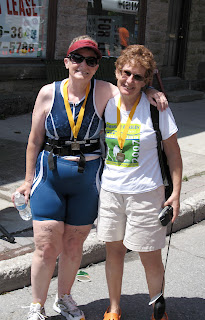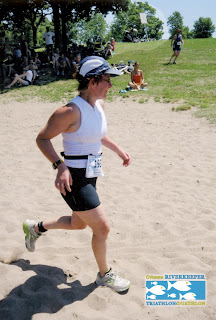

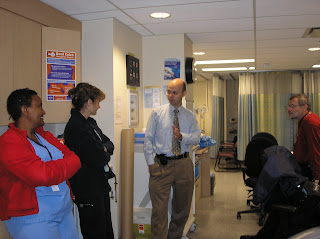
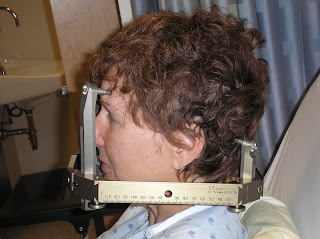
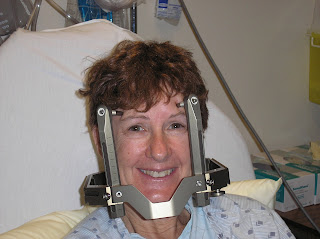
Ever since I was diagnosed with acoustic neuroma, I’ve been trying to get an article on the condition published so that there would be more awareness. The response from the media has been nil. Since I’m trying to use my blog for things I’m interested in, I decided to put some acoustic neuroma stuff here for those who have asked about it.
Louise
----
I didn’t do very well on the bird watching walk.
I couldn’t tell the leader’s bird call imitations from the real thing; I’d think it was real birds when he was just whistling. I couldn’t tell where the sounds were coming from.
And background music makes it impossible for me to make out the words when people are talking in restaurants, aerobics or spinning classes, anywhere.
Hearing loss sneaks up on you. Is everyone whispering or mumbling on purpose?
I write this as an explanation for those of you who may think I have on occasion been rude to you. I wasn’t ignoring you or intentionally giving an inappropriate response; I just couldn’t hear you properly or tell which direction the sound was coming from. And usually I was too embarrassed to tell you.
In fall 2003, I finally told Dr. Johnson, my family doctor, that I seemed to be having trouble hearing.
She referred me to Dr. Gregory Antoniak, ENT, for testing, which led to a CAT scan and an MRI.
That led to a referral to Dr. Brien Benoit, neurosurgeon. Months evolved in between all these appointments, and each one led to several phone calls to arrange an appointment for the next.
Finally, Dr. Benoit’s diagnosis was “acoustic neuroma.”
With MRIs more readily available, acoustic neuromas are being diagnosed more easily now, but their incidence is still very rare - about 2,500 people being diagnosed each year in the U.S.
Symptoms include decreased hearing, ringing in the ears and a change in balance. While acoustic neuromas can affect either ear and sometimes both ears, most often it is unilateral. The vast majority have asymmetric loss in hearing, most commonly high frequency hearing loss. An early sign is avoiding one ear while using a telephone.
My acoustic neuroma was slow growing, about 1 cm.
It’s nothing I did or didn’t do, and it’s not hereditary.
Three choices:
I-1. Do nothing, observe. 2. Do another scan in a year and see if it’s growing.
(If I were 20, he’d say do the surgery for sure. If I were 70 or had a serious illness, he’d say don’t do it. At my point in life, he says it’s up to me. “How long are you going to live?” he asks. “If it’s another 25 years, well, it’s easier to do the operation while the growth is small.”)
II- Operation
Through the ear.
Lose hearing on the right side, but less chance to lose facial nerve. Tail on tumour makes hearing-saving operation through brain chances not good.
10 per cent chance of facial nerve loss.
Surgery in hospital a week, off balance and off work about a month or two.
III - Stereotactic radiosurgery.
Same as cancer radiology. It stops growth but doesn’t take it out. Some side effects. Done by neuro otologist.
I am leaning towards number II. There is at least a six-month to year wait anyway, so I’m thinking of reserving now for a year July.
Wednesday June 30th, 2004.
Hearing test appointment 20 min. then Dr. David Schramm, who says, have another MRI in October to monitor the growth rate. If it is slow, we can wait a bit more. Otherwise schedule an operation for spring, three or four months later.
Nov. 2/04 2nd MRI
Nov. 24 10 a.m. follow-up hearing test and appt. with Dr. Schramm. That showed no growth in tumour in the important area, but hearing worse. He said surgery not necessary yet.
June 12/05 3rd MRI Civic Campus.
Wednesday August 31 10:45 a.m. Follow-up appointment Dr. Schramm. He says the MRI shows size of tumour is the same. However he says it’s usual for hearing to continue to deteriorate as mine has; he doesn’t know why.
If I have any numbness or weakness on the right side of my face, I am to call him right away. Otherwise I will have another MRI in May, with follow-up in June 06. Radiation wouldn’t be a good choice, because there’s not much hearing to save, and the tumour could grow back, and necessitate surgery anyway, he said.
With surgery, any attempt to save the hearing would cause more risk to the facial nerve, so once I have surgery, there will be no hearing on my right side. I would have the surgery within six months of being scheduled. He says some of his patients don’t like the ongoing uncertainty and opt for surgery. He recommends waiting, since there’s nothing to gain, and there are surgical risks. I wait.
December /05
My hearing continues to get worse. At any round table event or party, or skiing, running or driving with someone on my right, which is my ‘wrong’ side, I miss totally or misinterpret what is being said. It is very frustrating and makes me hesitate to attend large gatherings. I can understand why some people become hermits.
May 9 /06
Another MRI at the Civic Campus, a few weeks after my application for long term disability insurance has been rejected by the insurance company. Apparently they are spooked by the possibility of surgery in my future. My sedentary husband was approved.
June 26/06
The neuroma has grown to 2 cm, and it is time for an appointment with Dr. Benoit the neurosurgeon.
Dr. Benoit says again, three choices:
- Surgery in Ottawa done by Dr. Schramm and Dr. Benoit.
- Linac radiation done in Ottawa.
- Gamma knife radiation done in Toronto at the Joey & Toby Tanenbaum Gamma Knife Centre at Toronto Western Hospital.
He won’t make the decision for me, and sends me off to the Internet to do my own research. I am surprised that radiation is now considered a viable option, when I had been told previously it wasn’t.
Radiation gives minimal risk right now, but possible long term difficulty later, as opposed to invasive surgery now. I opt for radiation, grateful to have an option to surgery. I will lose the little hearing I have left in my right ear.
And I wait for a call-back from Dr. Benoit’s office about a time for gamma knife radiosurgery in Toronto.
Early September
I finally get a voicemail call at home late Friday from Toronto Western Hospital.
A week goes by, and I finally make contact. The appointment is set for an assessment on Tuesday October 24, and gamma knife the following morning.
A few weeks before the radiation, I receive a call from the University Health Network about taking part in a pilot study “Exploring the Role of 3T MRI in Gamma Knife Radiosurgery.”
It requires undergoing a research MRI test prior to treatment, using a stronger magnet than standard MRI scanners, and use of a breathing device with oxygen and carbon dioxide. “It is possible that 3T MRI will give us additional information that will help plan and assess your treatment more accurately,” said the consent form. “Information learned from this study may also benefit other patients in the future with your disease.”
I decide to consent to the second MRI which was right after the one that was party of my treatment. It turned out to be very difficult because it doubled the time I was flat on my back in the machine. I am not claustrophobic, but I am a fuss budget, and there’s no room to fidget in an MRI machine.
I am also a Pollyanna, and had underestimated the demands of the treatment, thinking I’d be back on the train to Ottawa the same afternoon.
Gamma Knife day began at 6 a.m. and ended late in the day. It’s not actually a knife, it’s using very precise beams of radiation to treat affected areas of the brain (the target). At the target, the concentrated radiation destroys the tumor. Because the beams are precisely pinpointed on the target, damage from radiation to surrounding brain tissue is small.
The four steps to gamma knife treatment are putting on the frame, imaging, treatment planning, and treatment.
The stereotactic head frame is attached to my head with four pins, two on the forehead and two in the back of my head. The frame stays on my head for the entire procedure, to keep me in a stable position during imaging and treatment. A transparent box is is placed on top of the frame to measure the depth of my skull.
After the images are taken, I wait back in my room while the neurosurgeon, radiation oncologist, radiologist, neurologist and medical physicist treatment planning team decides which areas to treat, how much radiation to give, and how they will target the radiation. That takes several hours.
After treatment the neurosurgeon removed the head frame, and bandages were put on the pin sites on my forehead. Symptoms afterward included mild headache, some bleeding, and swelling around my eyes caused by the local anesthetic.
I was back at work two days later.
My hearing will continue to decline, but hopefully the growth of the tumor has been stopped.
Six month follow-up
Toronto Western Hospital April 25, 2007. Dr. Menard said size of the tumour is the same, so that’s good; no growth.
Another six-month appointment has been made for October 31st.
